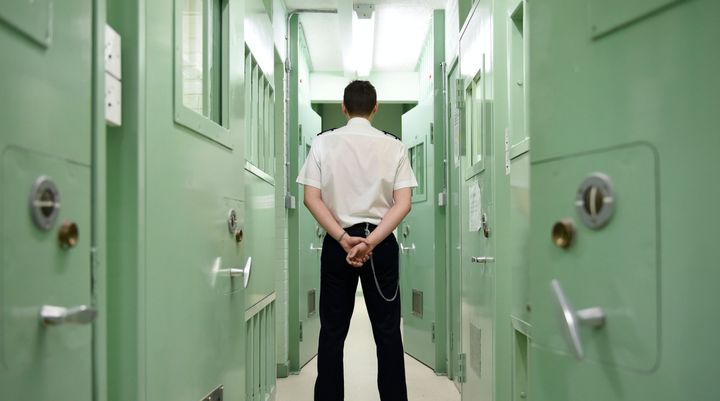Get the latest on coronavirus. Sign up to the Daily Brief for news, explainers, how-tos, opinion and more.
The government has been accused of “abandoning” a prisoner early release scheme to ease the impact of coronavirus on jails – despite spending almost £4m on electronic tags to carry out the plan.
In April, the Ministry of Justice pledged to release up to 4,000 low-risk prisoners on temporary licence to ease overcrowding, as well as pregnant inmates and mothers with babies.
But the latest figures show just 153 prisoners have been let out under the End of Custody Temporary Release (ECTR) scheme and compassionate release in light of Covid-19.
The limited number of releases comes despite the department spending £3.8m on 2,000 electronic tags to monitor prisoners, according to a response to a parliamentary question tabled by Labour’s shadow justice secretary David Lammy.
“It is untenable to continue to subject the entire prison population to conditions of what are, in effect, prolonged solitary confinement with no access to education or other meaningful activities.””
- The Howard League for Penal Reform and the Prison Reform Trust
The Ministry of Justice says the prison population has fallen by almost 4,000 inmates since mid-March and points to a “compartmentalisation strategy” that has “saved thousands of lives”. It adds tags can still be used on others.
But prison reform campaigners have now written to the department to complain about the “inhumane and untenable” conditions inmates are being kept in, and are calling for the release of a “substantial” number of prisoners.
A joint letter from the Howard League for Penal Reform and the Prison Reform Trust to justice secretary Robert Buckland warns of most people in prison being kept in either “prolonged solitary confinement or in overcrowded conditions”.
The organisations write: “Despite the additional resources that have been given to prisons to cope with the crisis, each and every report from the Inspectorate has painted a clear, bleak picture: prisons are devoid of purposeful activity and opportunities for people to make amends.
“The children in prison have had no education, rates of self-harm in women’s prisons have increased and the entire estate has been starved of contact with the outside world. Open prisons no longer serve their function of preparing people for the community.”
Lammy told HuffPost UK the cost of the tags underlined the “haphazard response to the pandemic”.
He said: “It paid almost £4m for 2,000 extra tags for its early release scheme, most of which it never used.
“Overcrowded prisons are vulnerable to the spread of the virus in this pandemic. The government must not be complacent about the threat of a second wave.”

In April, the MoJ signed contracts with Buddi Ltd and Attenti EM UK to provide 2,000 electronic monitoring tags between them. The department has said it is considering “alternative uses” for tags not required for the ECTR scheme.
Cases of coronavirus have been confirmed in 105 out of 117 prisons so far, and 23 inmates have died.
Some 971 prison staff and 502 inmates have tested positive, including those who have recovered.
According to one report, prisoners with coronavirus symptoms were locked in cells for up to two weeks without being allowed out to shower.
The findings emerged following inspections of conditions in three jails – Wandsworth in south London, Altcourse in Liverpool, and Elmley on the Isle of Sheppey.
In a report published last month, chief inspector of prisons Peter Clarke said: “The vast majority were locked up for nearly the whole day with usually no more than half an hour out of their cells.
“We found some examples of even greater restrictions. In one prison, a small number of symptomatic prisoners had been isolated in their cells without any opportunity to come out for a shower or exercise for up to 14 days.”
The Home Detention Curfew (HDC) scheme, introduced in 1999, means inmates can be released with an electronic tag and under a curfew up to four-and-a-half months prior to their scheduled release date. Prisoners jailed for at least three months and less than four years can be considered for release on HDC.
Criminals in several offence categories are either barred or “presumed unsuitable”, including sex offenders, terrorists and foreign national prisoners facing deportation.
The programme to release up to 4,000 inmates had to be put on hold after six prisoners were released by mistake due to an “administrative error” before being returned to prison. Last month, the Lord Chief Justice of England and Wales urged the courts to consider the conditions in prison when sentencing, which partly explains the fall in the prison population.
In the letter, the Howard League and Prison Reform Trust write: “Either you must release a substantial number of prisoners so that prisons are less overcrowded and the need for prolonged solitary confinement disappears, or you must take some other urgent step to initiate a humane and meaningful regime in our prisons.
“It is untenable in the medium or indeed short terms to continue to subject the entire prison population to conditions of what are, in effect, prolonged solitary confinement with no access to education or other meaningful activities.”
On tags, the letter said: “It is clear that despite investing almost £4 million in electronic tagging to secure early releases and advising us on 28 April 2020 that you had approved releases of 200 people under the ECTR scheme, that system is effectively abandoned.”
In response to the parliamentary question, prisons minister Lucy Frazer wrote: “Her Majesty’s Prison and Probation Service has worked with individual establishments and local health teams to identify the most appropriate way to implement the compartmentalisation strategy in each prison, in line with national guidance.
“Full implementation will require around 5,000 to 5,500 additional headroom, from a combination of reduced demand and increased supply of places.
“This is being delivered through a range of means, including a reduction in the population, support for early release schemes, expediting of remand cases, and expansion of the estate.
“Available data shows that since mid-March the overall prison population has fallen by almost 4,000. As at Friday, May 29, 716 temporary accommodation units have been delivered to 23 HMPPS sites and 128 prisoners have been released under the End of Custody Temporary Release Scheme and compassionate release in light of Covid-19.
“We have also brought the former Medway Secure Training Centre back into operation temporarily as an annex to HMP/YOI Rochester. The location will provide temporary accommodation for 70 category D adult males.
“We are currently on track to have fully implemented compartmentalisation across the estate over the next couple of months and continue to work with establishments and review our plans to ensure we are implementing it in the most efficient manner possible.”
A Ministry of Justice spokesperson said: “It was only right that we put public protection first and acquired enough tags to fit everyone that could have been released on the scheme.
“This was just one part of our plan to contain the spread of coronavirus in prisons however, alongside creating extra cells isolating those with symptoms and quarantining new arrivals.
“This plan has saved thousands of lives and the extra capacity we have created has meant we haven’t had to release as many prisoners early as first thought.”

